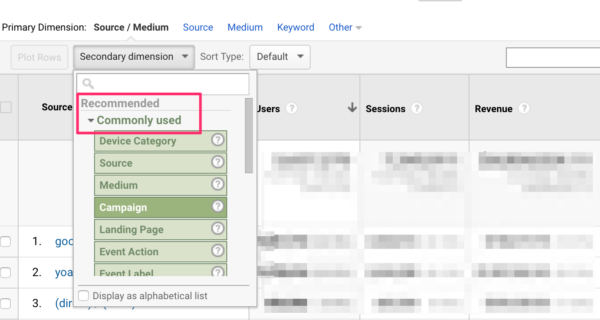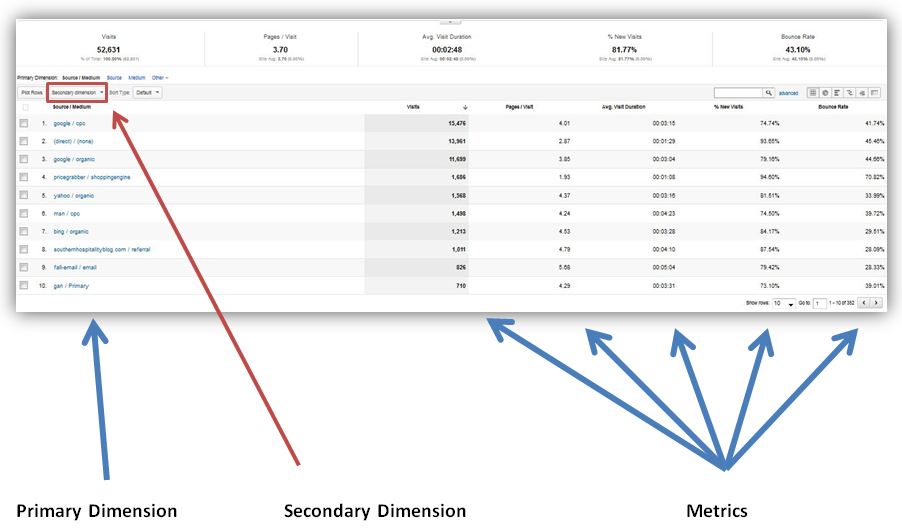The Value of 'Secondary Dimensions' in Google Analytics: In-depth Analysis
Decoding the Relevance of Additional Dimension in Google Analytics: Everything About Its Significance and Effect
In the realm of digital analytics, the application of second dimensions within Google Analytics offers as an essential tool for discerning much deeper layers of data understandings. The importance of secondary dimensions lies in their capability to offer a nuanced view of user actions and interaction with a site or system.
Recognizing Second Measurements in Google Analytics
The understanding of secondary measurements in Google Analytics is vital for getting deeper insights right into user actions and website efficiency. While primary measurements give fundamental data points such as website traffic sources and web page sights, secondary measurements enable an extra nuanced analysis by offering added context to these primary metrics. By including second dimensions, users can segment and filter their data to reveal patterns and patterns that may not be instantly obvious.

Revealing the Advantages of Secondary Dimensions
Structure upon the foundational understanding of secondary dimensions in Google Analytics, exploring the benefits they offer discloses very useful insights for improving information evaluation and decision-making. By integrating second dimensions, individuals can delve deeper into their information, acquiring a more extensive sight of individual behavior, material efficiency, and various other key metrics. One of the main advantages is the capacity to sector data, permitting a much more granular analysis of different dimensions such as traffic sources, gadgets, demographics, and a lot more. This segmentation makes it possible for customers to identify patterns, fads, and correlations that may not appear when taking a look at information in accumulation.
Furthermore, secondary measurements give context to main information, using added layers of info that can aid in recognizing individual communications and choices. This boosted understanding can lead calculated decision-making, causing more targeted advertising campaigns, website optimizations, and total enhanced efficiency. Essentially, secondary dimensions work as a powerful device for opening much deeper insights and optimizing the energy of Google Analytics for companies and website owners.
Leveraging Additional Measurements for Boosted Insights
By taking advantage of the power of secondary dimensions in Google Analytics, services can discover deeper understandings that drive informed decision-making and calculated optimization efforts. Leveraging second dimensions permits businesses to dive past surface-level data and get a more extensive understanding of individual habits, target market demographics, traffic sources, and internet site efficiency. By combining key dimensions like web traffic resources with additional measurements such as geographic place or tool classification, organizations can recognize which gadgets or areas are driving the most important web traffic to their site.
Furthermore, secondary dimensions make it possible for services to section and assess information better, assisting them recognize patterns, patterns, and chances that might have or else gone unnoticed. By using additional measurements, services can customize their advertising strategies, material, and individual experience to much better meet the requirements and preferences of their target market. In significance, leveraging secondary dimensions in Google Analytics empowers companies to make data-driven choices that result in improved performance, boosted ROI, and sustainable growth.

Impact of Additional Dimensions on Information Evaluation
Enhancing information analysis with the usage of secondary measurements in Google Analytics provides companies with a much deeper understanding of their on-line performance metrics. By integrating second dimensions, such as time of day, geographical location, or gadget classification, organizations can reveal important insights that might have been overlooked with main measurements alone. This improved degree of granularity enables even more precise segmentation of information, allowing companies to determine patterns, trends, and correlations that can drive strategic decision-making.

Maximizing Possible: Second Capacities Approaches
One key method is to integrate second try this site dimensions with main measurements to acquire a comprehensive sight of individual interactions. Pairing the main dimension of 'source/medium' with second dimensions like 'touchdown web page' or 'tool group' can disclose which networks are driving web traffic to particular web pages or just how individual behavior varies across devices.
Moreover, utilizing secondary measurements to sector information based on user demographics, actions, or innovation can aid businesses customize their advertising efforts to details audience sectors. This targeted approach can lead to improved conversion rates, enhanced individual experiences, and inevitably, increased ROI. By maximizing the possibility of additional dimensions in Google Analytics, services can make enlightened choices, maximize their on the internet existence, and drive lasting development.
Verdict
In final thought, secondary measurements in Google Analytics play a critical function in giving deeper understandings and improving data evaluation. By utilizing additional measurements efficiently, businesses can gain an extra thorough understanding of customer habits and web site efficiency. Integrating secondary measurements right into information evaluation techniques can bring about more informed decision-making and boosted overall efficiency. It is vital for companies to leverage the power of additional measurements to maximize their potential and achieve greater success in their on the internet undertakings (what is a “secondary dimension” in google analytics?).
While key dimensions supply essential data points such as web traffic resources and page sights, additional dimensions allow for a much more more nuanced evaluation by offering additional context to these key metrics. By integrating primary dimensions like website traffic sources with second dimensions such as geographical area or tool group, companies can determine which gadgets or areas are driving the most beneficial web traffic to their web site.
By incorporating second dimensions, such as time of day, geographical location, or device group, businesses can discover beneficial understandings that might have been overlooked with key measurements alone. One key strategy is to combine secondary measurements with primary measurements to obtain a detailed sight of individual communications. Pairing the primary measurement of 'source/medium' with second more information dimensions like 'touchdown web page' or 'device category' can expose which channels are driving website traffic to specific web pages or how user habits varies across tools.